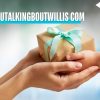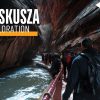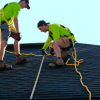With increasing urbanization, population growth and the need for reliable infrastructure, it’s not surprising that the need for a diverse set of soil stabilization techniques suitable for a variety of soil and project conditions has seen matching growth. In 2017, the global soil stabilization market reached a massive US $22 Billion, and is expected to reach US $29 billion by 2023. Here we take a look at some of the soil stabilization techniques leading the field in innovation and market growth.
Chemical stabilization through the addition of Lime:
The addition of lime, lime kiln dust or quicklime is a popular form of soil modification and stabilization for all types of soft soils, especially wet, fine-grained and clay soils. Essentially it reacts with clay molecules, which hardens and dries out the soil with which it is mixed, improving stability and soil compressibility.
Lime is the oldest soil stabilization technique still in use today and can be greatly advantageous for particularly muddy construction sites which make accessing the site difficult, and it’s also cheap. It does, however, have several disadvantages too. The production process is very energy intensive, resulting in large CO2 emissions, as high as 1.2 tons of CO2 per ton of lime produced. Achieving homogenous application is tricky, there is risk of environmental toxicity, and application over very soft soil is problematic due to the heavy earth-mixing equipment required for application.
Mechanical soil stabilization through the use of Geocell engineering:
Although geocells have been around since the 1970’s, the increasing global demand for more environmentally sustainable and cost-effective construction techniques has seen renewed interest in their use. Geocells – a type of geosynthetic – are constructed from strips of a novel polymeric alloy called Neoloy, which are welded together to form a honeycomb-like grid when stretched out on site. They are then filled in with local granular materials that are readily available, such as sandy soils or even recycled asphalt paving (RAP).
The main environmental benefits include the ability to utilize local granular materials for infill rather than hauling in high-quality aggregates from quarries, a reduction in the required pavement thickness, improved durability of projects, and the ongoing cost benefit of reduced maintenance requirements.
While awareness of this technology remains its biggest challenge, it is gaining a reputation as a good option for projects with poor soil or challenging environmental conditions. One prime example of this was the construction of an all-weather access road for MEG Energy in the Muskeg peat bog, which made use of geocell engineering in Canada. Some of the challenges facing the engineers on site included moving vehicles and materials around on the saturated, acidic soil, as well as subzero winter temperatures, extremely poor drainage and heavy rains which meant much of the site was essentially a swamp – described, in fact, as an ‘engineering nightmare’.
An example of the less than ideal working conditions – geocell layer visible in back
Because the peat bog soil was too deep and poorly drained for soil replacement, it soon became clear that the use of heavy-duty Neoloy geocells was the only feasible solution. Local geocell experts designed a reinforced road using one to three layers of Neoloy geocells, depending on the saturation level of the area in question. Once in place, the geocells were filled in with sand from locally available borrow pits and then compacted. The geocell layers formed a semi-rigid mattress, or a ‘floating road’ over the swampy soil. The benefits of geocell mechanical soil stabilization include: reducing stress by distributing vertical loads and extending the life of the road – meaning that even heavy rigs and construction equipment could now traverse the peat bog on a regular basis.
Compaction grouting for sinkhole remediation:
Building much-needed apartment housing is one thing but doing so on an area of land which is essentially one giant sinkhole is another matter altogether! This was the challenge facing contractors trying to put up a new five story complex in King of Prussia in Montgomery County, Pennsylvania. Understandably, no work on the apartment building could begin until the underlying dolomite subsoil was stabilized. The solution they arrived at was the use of compaction grouting, which involves drilling columns in a grid-like pattern, and then injecting a low-mobility soil-cement grout into the holes at high pressures. This process compacts coarse-grained soils and displaces fine-grained soils, allowing the construction site to withstand higher bearing pressures and reduce settlement – both very important in an area to prone to sinkholes.
Under normal conditions, a soil profile increases in strength with depth – but on this site, the dense clays were on the surface, with weaker soils above the bedrock – hence the tendency for sinkholes to form. Drilling down to reach the unstable layer was therefore the best solution in this scenario. To complete the stabilization, the contractor – Compaction Grouting Services, Inc. or CGS – needed to drill 626 separate holes, and pump in 820 cubic yards of grout at an average pressure of 300 psi. And despite a number of challenges, including snow, rain and muddy conditions as well as a small sinkhole which opened up in an area which hadn’t been grouted – they managed to finish a day ahead of schedule.
Read Also:





















